Xiaoyan Kui
TFKAN: Time-Frequency KAN for Long-Term Time Series Forecasting
Jun 15, 2025Abstract:Kolmogorov-Arnold Networks (KANs) are highly effective in long-term time series forecasting due to their ability to efficiently represent nonlinear relationships and exhibit local plasticity. However, prior research on KANs has predominantly focused on the time domain, neglecting the potential of the frequency domain. The frequency domain of time series data reveals recurring patterns and periodic behaviors, which complement the temporal information captured in the time domain. To address this gap, we explore the application of KANs in the frequency domain for long-term time series forecasting. By leveraging KANs' adaptive activation functions and their comprehensive representation of signals in the frequency domain, we can more effectively learn global dependencies and periodic patterns. To integrate information from both time and frequency domains, we propose the $\textbf{T}$ime-$\textbf{F}$requency KAN (TFKAN). TFKAN employs a dual-branch architecture that independently processes features from each domain, ensuring that the distinct characteristics of each domain are fully utilized without interference. Additionally, to account for the heterogeneity between domains, we introduce a dimension-adjustment strategy that selectively upscales only in the frequency domain, enhancing efficiency while capturing richer frequency information. Experimental results demonstrate that TFKAN consistently outperforms state-of-the-art (SOTA) methods across multiple datasets. The code is available at https://github.com/LcWave/TFKAN.
Mamba Based Feature Extraction And Adaptive Multilevel Feature Fusion For 3D Tumor Segmentation From Multi-modal Medical Image
Apr 30, 2025Abstract:Multi-modal 3D medical image segmentation aims to accurately identify tumor regions across different modalities, facing challenges from variations in image intensity and tumor morphology. Traditional convolutional neural network (CNN)-based methods struggle with capturing global features, while Transformers-based methods, despite effectively capturing global context, encounter high computational costs in 3D medical image segmentation. The Mamba model combines linear scalability with long-distance modeling, making it a promising approach for visual representation learning. However, Mamba-based 3D multi-modal segmentation still struggles to leverage modality-specific features and fuse complementary information effectively. In this paper, we propose a Mamba based feature extraction and adaptive multilevel feature fusion for 3D tumor segmentation using multi-modal medical image. We first develop the specific modality Mamba encoder to efficiently extract long-range relevant features that represent anatomical and pathological structures present in each modality. Moreover, we design an bi-level synergistic integration block that dynamically merges multi-modal and multi-level complementary features by the modality attention and channel attention learning. Lastly, the decoder combines deep semantic information with fine-grained details to generate the tumor segmentation map. Experimental results on medical image datasets (PET/CT and MRI multi-sequence) show that our approach achieve competitive performance compared to the state-of-the-art CNN, Transformer, and Mamba-based approaches.
Iterative Collaboration Network Guided By Reconstruction Prior for Medical Image Super-Resolution
Apr 23, 2025Abstract:High-resolution medical images can provide more detailed information for better diagnosis. Conventional medical image super-resolution relies on a single task which first performs the extraction of the features and then upscaling based on the features. The features extracted may not be complete for super-resolution. Recent multi-task learning,including reconstruction and super-resolution, is a good solution to obtain additional relevant information. The interaction between the two tasks is often insufficient, which still leads to incomplete and less relevant deep features. To address above limitations, we propose an iterative collaboration network (ICONet) to improve communications between tasks by progressively incorporating reconstruction prior to the super-resolution learning procedure in an iterative collaboration way. It consists of a reconstruction branch, a super-resolution branch, and a SR-Rec fusion module. The reconstruction branch generates the artifact-free image as prior, which is followed by a super-resolution branch for prior knowledge-guided super-resolution. Unlike the widely-used convolutional neural networks for extracting local features and Transformers with quadratic computational complexity for modeling long-range dependencies, we develop a new residual spatial-channel feature learning (RSCFL) module of two branches to efficiently establish feature relationships in spatial and channel dimensions. Moreover, the designed SR-Rec fusion module fuses the reconstruction prior and super-resolution features with each other in an adaptive manner. Our ICONet is built with multi-stage models to iteratively upscale the low-resolution images using steps of 2x and simultaneously interact between two branches in multi-stage supervisions.
Global and Local Mamba Network for Multi-Modality Medical Image Super-Resolution
Apr 14, 2025Abstract:Convolutional neural networks and Transformer have made significant progresses in multi-modality medical image super-resolution. However, these methods either have a fixed receptive field for local learning or significant computational burdens for global learning, limiting the super-resolution performance. To solve this problem, State Space Models, notably Mamba, is introduced to efficiently model long-range dependencies in images with linear computational complexity. Relying on the Mamba and the fact that low-resolution images rely on global information to compensate for missing details, while high-resolution reference images need to provide more local details for accurate super-resolution, we propose a global and local Mamba network (GLMamba) for multi-modality medical image super-resolution. To be specific, our GLMamba is a two-branch network equipped with a global Mamba branch and a local Mamba branch. The global Mamba branch captures long-range relationships in low-resolution inputs, and the local Mamba branch focuses more on short-range details in high-resolution reference images. We also use the deform block to adaptively extract features of both branches to enhance the representation ability. A modulator is designed to further enhance deformable features in both global and local Mamba blocks. To fully integrate the reference image for low-resolution image super-resolution, we further develop a multi-modality feature fusion block to adaptively fuse features by considering similarities, differences, and complementary aspects between modalities. In addition, a contrastive edge loss (CELoss) is developed for sufficient enhancement of edge textures and contrast in medical images.
A Comprehensive Survey on Magnetic Resonance Image Reconstruction
Mar 10, 2025Abstract:Magnetic resonance imaging (MRI) reconstruction is a fundamental task aimed at recovering high-quality images from undersampled or low-quality MRI data. This process enhances diagnostic accuracy and optimizes clinical applications. In recent years, deep learning-based MRI reconstruction has made significant progress. Advancements include single-modality feature extraction using different network architectures, the integration of multimodal information, and the adoption of unsupervised or semi-supervised learning strategies. However, despite extensive research, MRI reconstruction remains a challenging problem that has yet to be fully resolved. This survey provides a systematic review of MRI reconstruction methods, covering key aspects such as data acquisition and preprocessing, publicly available datasets, single and multi-modal reconstruction models, training strategies, and evaluation metrics based on image reconstruction and downstream tasks. Additionally, we analyze the major challenges in this field and explore potential future directions.
Self-Prior Guided Mamba-UNet Networks for Medical Image Super-Resolution
Jul 08, 2024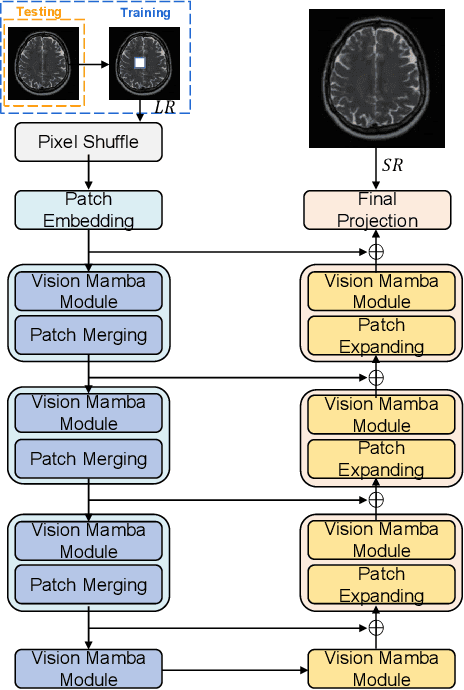

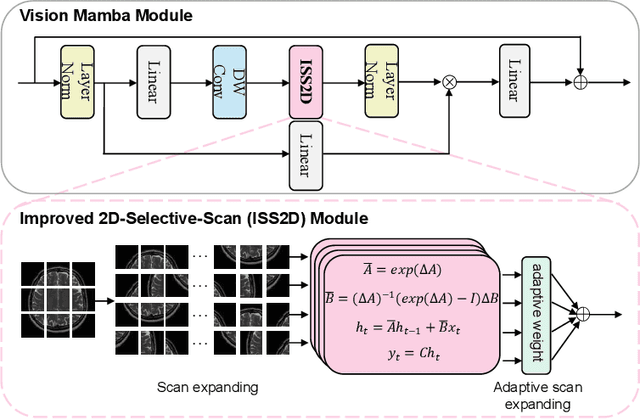
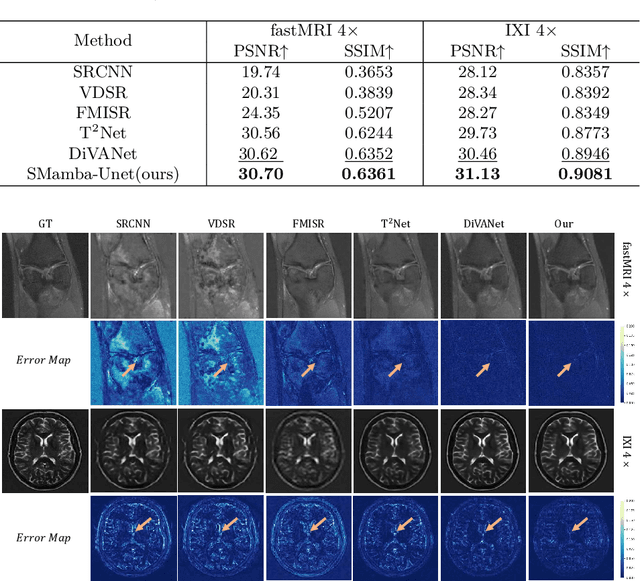
Abstract:In this paper, we propose a self-prior guided Mamba-UNet network (SMamba-UNet) for medical image super-resolution. Existing methods are primarily based on convolutional neural networks (CNNs) or Transformers. CNNs-based methods fail to capture long-range dependencies, while Transformer-based approaches face heavy calculation challenges due to their quadratic computational complexity. Recently, State Space Models (SSMs) especially Mamba have emerged, capable of modeling long-range dependencies with linear computational complexity. Inspired by Mamba, our approach aims to learn the self-prior multi-scale contextual features under Mamba-UNet networks, which may help to super-resolve low-resolution medical images in an efficient way. Specifically, we obtain self-priors by perturbing the brightness inpainting of the input image during network training, which can learn detailed texture and brightness information that is beneficial for super-resolution. Furthermore, we combine Mamba with Unet network to mine global features at different levels. We also design an improved 2D-Selective-Scan (ISS2D) module to divide image features into different directional sequences to learn long-range dependencies in multiple directions, and adaptively fuse sequence information to enhance super-resolved feature representation. Both qualitative and quantitative experimental results demonstrate that our approach outperforms current state-of-the-art methods on two public medical datasets: the IXI and fastMRI.
Deform-Mamba Network for MRI Super-Resolution
Jul 08, 2024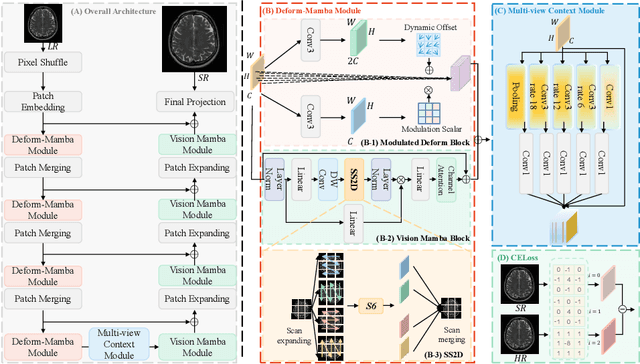


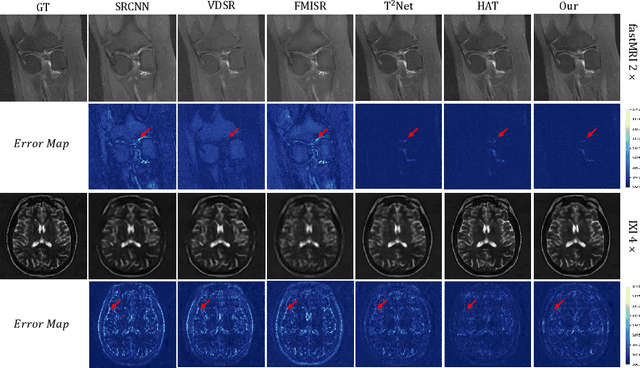
Abstract:In this paper, we propose a new architecture, called Deform-Mamba, for MR image super-resolution. Unlike conventional CNN or Transformer-based super-resolution approaches which encounter challenges related to the local respective field or heavy computational cost, our approach aims to effectively explore the local and global information of images. Specifically, we develop a Deform-Mamba encoder which is composed of two branches, modulated deform block and vision Mamba block. We also design a multi-view context module in the bottleneck layer to explore the multi-view contextual content. Thanks to the extracted features of the encoder, which include content-adaptive local and efficient global information, the vision Mamba decoder finally generates high-quality MR images. Moreover, we introduce a contrastive edge loss to promote the reconstruction of edge and contrast related content. Quantitative and qualitative experimental results indicate that our approach on IXI and fastMRI datasets achieves competitive performance.
Ada-DF: An Adaptive Label Distribution Fusion Network For Facial Expression Recognition
Apr 24, 2024Abstract:Facial expression recognition (FER) plays a significant role in our daily life. However, annotation ambiguity in the datasets could greatly hinder the performance. In this paper, we address FER task via label distribution learning paradigm, and develop a dual-branch Adaptive Distribution Fusion (Ada-DF) framework. One auxiliary branch is constructed to obtain the label distributions of samples. The class distributions of emotions are then computed through the label distributions of each emotion. Finally, those two distributions are adaptively fused according to the attention weights to train the target branch. Extensive experiments are conducted on three real-world datasets, RAF-DB, AffectNet and SFEW, where our Ada-DF shows advantages over the state-of-the-art works.
ChebMixer: Efficient Graph Representation Learning with MLP Mixer
Mar 25, 2024Abstract:Graph neural networks have achieved remarkable success in learning graph representations, especially graph Transformer, which has recently shown superior performance on various graph mining tasks. However, graph Transformer generally treats nodes as tokens, which results in quadratic complexity regarding the number of nodes during self-attention computation. The graph MLP Mixer addresses this challenge by using the efficient MLP Mixer technique from computer vision. However, the time-consuming process of extracting graph tokens limits its performance. In this paper, we present a novel architecture named ChebMixer, a newly graph MLP Mixer that uses fast Chebyshev polynomials-based spectral filtering to extract a sequence of tokens. Firstly, we produce multiscale representations of graph nodes via fast Chebyshev polynomial-based spectral filtering. Next, we consider each node's multiscale representations as a sequence of tokens and refine the node representation with an effective MLP Mixer. Finally, we aggregate the multiscale representations of nodes through Chebyshev interpolation. Owing to the powerful representation capabilities and fast computational properties of MLP Mixer, we can quickly extract more informative node representations to improve the performance of downstream tasks. The experimental results prove our significant improvements in a variety of scenarios ranging from graph node classification to medical image segmentation.
ChatRadio-Valuer: A Chat Large Language Model for Generalizable Radiology Report Generation Based on Multi-institution and Multi-system Data
Oct 10, 2023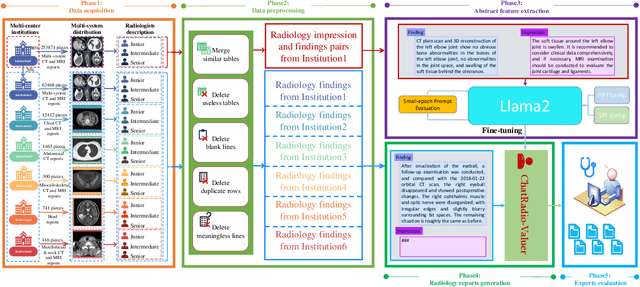
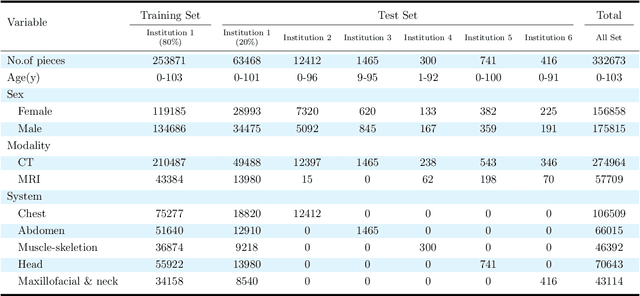
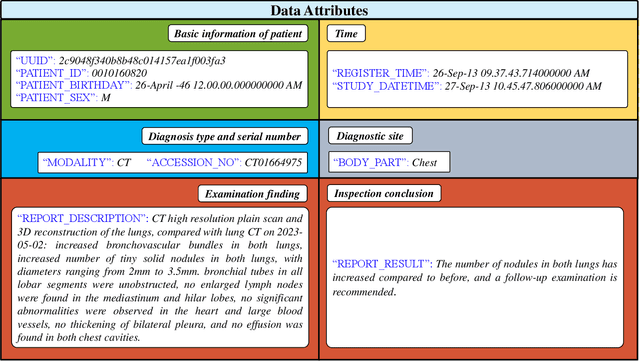
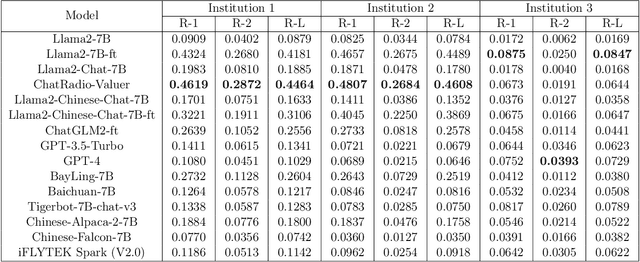
Abstract:Radiology report generation, as a key step in medical image analysis, is critical to the quantitative analysis of clinically informed decision-making levels. However, complex and diverse radiology reports with cross-source heterogeneity pose a huge generalizability challenge to the current methods under massive data volume, mainly because the style and normativity of radiology reports are obviously distinctive among institutions, body regions inspected and radiologists. Recently, the advent of large language models (LLM) offers great potential for recognizing signs of health conditions. To resolve the above problem, we collaborate with the Second Xiangya Hospital in China and propose ChatRadio-Valuer based on the LLM, a tailored model for automatic radiology report generation that learns generalizable representations and provides a basis pattern for model adaptation in sophisticated analysts' cases. Specifically, ChatRadio-Valuer is trained based on the radiology reports from a single institution by means of supervised fine-tuning, and then adapted to disease diagnosis tasks for human multi-system evaluation (i.e., chest, abdomen, muscle-skeleton, head, and maxillofacial $\&$ neck) from six different institutions in clinical-level events. The clinical dataset utilized in this study encompasses a remarkable total of \textbf{332,673} observations. From the comprehensive results on engineering indicators, clinical efficacy and deployment cost metrics, it can be shown that ChatRadio-Valuer consistently outperforms state-of-the-art models, especially ChatGPT (GPT-3.5-Turbo) and GPT-4 et al., in terms of the diseases diagnosis from radiology reports. ChatRadio-Valuer provides an effective avenue to boost model generalization performance and alleviate the annotation workload of experts to enable the promotion of clinical AI applications in radiology reports.
 Add to Chrome
Add to Chrome Add to Firefox
Add to Firefox Add to Edge
Add to Edge